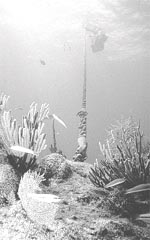Safe under water
 the ozone hole above Antarctica may not be damaging life in the ocean below. A team of researchers led by Kevin Arrigo of Stanford University in California, usa , has concluded that increased ultraviolet radiation has hardly affected marine plankton, the base of the ocean's food web.
the ozone hole above Antarctica may not be damaging life in the ocean below. A team of researchers led by Kevin Arrigo of Stanford University in California, usa , has concluded that increased ultraviolet radiation has hardly affected marine plankton, the base of the ocean's food web.
The team has created computer models of phytoplankton growth over a year in the Southern Hemisphere before and after the ozone hole appeared in the 1980s. They included such factors as the position of the ozone hole, cloud cover and uv-b strength (the type of ultraviolet radiation that increases as atmospheric ozone declines).
The researchers used two models to find out what increased uv-b did to phytoplankton.One model was based on data from 1992, a year with a huge ozone hole, while the other was fed with the same parameters except for the ozone levels, which were taken from 1978, a year of normal conditions before the hole appeared.
They found that over the Southern Hemisphere ecosystem as a whole, primary plankton production decreased by about 1 per cent in 1992, which is significantly lower than other estimates. The latest findings do not dispute the results of a number of studies showing that increased uv-b can stunt phytoplankton growth by 10 per cent or more in localised areas or in the laboratory. The difference is that Arrigo's study looked at the total picture of uv-b for the whole ocean (New Scientist , Vol 165, No 2226).
What earlier researchers had done was scale up measurements of plankton growth beneath the hole and elsewhere to calculate an overall effect for the whole Southern Ocean. But although they knew that factors such as cloud cover were important, they are difficult to include in such calculations.
"On a cloudy day under a deep hole, there's still not nearly as much uv flux as on a clear day with no hole," says Arrigo. Another important factor is that, at any given time, around 80 per cent of the Southern Hemisphere's ozone hole is over ice. So, only a small fraction of plankton in the Southern Ocean waters feels the full brunt of ozone depletion, he says. Both these factors were incorporated into the new models.
Related Content
- World health statistics 2025: Monitoring health for the SDGs, Sustainable Development Goals
- Reply affidavit on behalf of the Central Ground Water Board (CGWB) regarding state of groundwater in Haryana, 03/05/2025
- Order of the National Green Tribunal regarding supply of safe and clean drinking water to areas affected by Guillain Barre Syndrome (GBS) disease, Pune, Maharashtra, 06/03/2025
- Dynamic ground water resources of Uttarakhand state, 2023
- Pollution of Adavikodu channel, an irrigation canal of river Godavari, Andhra Pradesh: APPCB report to the NGT
- Sanitation and hygiene for all: 'make a splash!' partnership progress report 2022-2023
